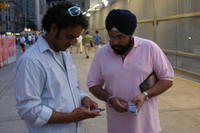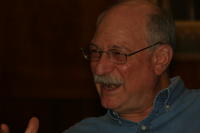When the Aftermath Began

That Tuesday morning, Amrik was in a cab three blocks south of the Towers, on his way to work when traffic stopped. He saw the family in the car next to him looking up at the sky, and Amrik followed their eyes to see the north tower on fire. He got out of the cab. There was a lamp post broken in half, and there embedded into the cement, a large tire wheel. It took him a few seconds to realize that this was the tire of an airplane. He heard a loud noise and looked up to see an airplane overhead.
 “The plane is loud and and moving so fast, and I follow it right into the building. It’s like the building just sucked up the plane. There’s a huge explosion and fire and smoke on the other side. And the debris goes everywhere. There’s already paper falling, because the wind blows in all directions. With papers falling everywhere, you see pieces of things burning in the air coming out of the building.
“The plane is loud and and moving so fast, and I follow it right into the building. It’s like the building just sucked up the plane. There’s a huge explosion and fire and smoke on the other side. And the debris goes everywhere. There’s already paper falling, because the wind blows in all directions. With papers falling everywhere, you see pieces of things burning in the air coming out of the building.
“I start running from the street to get underneath the scaffolding, and the debris is falling. I wait for the debris to fall. I wait to hear the noise all fall down. There’s a lady crawling on her hands and knees, trying to get underneath the scaffolding, her legs bloodied up to her knees. I pull her underneath the scaffolding, and help her on her feet. I’m thinking, ‘Head east, head south. Get off the island, get off the island.’ I walk east. Everyone’s in a walk-sprint, like a walking jog, because there are masses of people, and you can’t run.
“I turn south onto Broadway. Now I’m south of the World Trade Center, going east. Broadway comes to a fork with another street. I’m crossing on the north side of the triangle to the next street, and I see two guys coming the opposite way, crossing from the west side of the street. They point at me.
“The first guy says, ‘Hey, you better take off that f– turban!’ The second guy says, ‘You terrorist, you better take off that f– turban!’ I look at them, ignore them, and continue walking south. A third guy trailing behind them yells, “Hey you f– terrorist!” I turn left down the street and keep walking south. I look behind me and see them following fast. I break out into a run…”
Amrik ran for his life the second time in fifteen minutes. He escaped into a subway and made it out alive. This hate incident was the first of thousands that took place in the days and weeks and months and years that followed.
 Today, Amrik told me that the trauma of that day has subsided. Immediately afterward, he would dream about it and wake up remembering it. But now he focuses more on what that event revealed about America’s relations with the rest of the world, and Americans’ relations with each other.
Today, Amrik told me that the trauma of that day has subsided. Immediately afterward, he would dream about it and wake up remembering it. But now he focuses more on what that event revealed about America’s relations with the rest of the world, and Americans’ relations with each other.
“9/11 made us understand that from a national security standopoint, we underestimated the potential of our threat, and from a social and civil standpoint, how much we need to learn about each other… Still when I walk down the street everyday, inevitably somebody is staring. They want to make a comment, it’s just on their lips. People look at you. Even here in New York, it’s anywhere you go, whether it’s in a bar for a drink, a restaurant to eat, or on the path train. You know they want to say something. Sometimes it’s ‘Aren’t you a Sikh?’ and sometimes, ‘Hey towel-head.'”
 Amrik is married now. He has a good job and lives in Hoboken. He is happy, and this was a contrast from our last meeting in December 2001. It was good for me to see this- hopeful. (In the picture, Sharat and Amrik are ‘beaming’ their numbers to each other over fancy phones. It did not work of course.)
Amrik is married now. He has a good job and lives in Hoboken. He is happy, and this was a contrast from our last meeting in December 2001. It was good for me to see this- hopeful. (In the picture, Sharat and Amrik are ‘beaming’ their numbers to each other over fancy phones. It did not work of course.)
 An interesting side note: I interviewed Amrik at the same time as pulitzer-prize winning author DALE MAHARIDGE who was working on a book about the backlash. That winter, Dale became my writing professor at Stanford University, where we continued to share notes about our journeys. Last year, Dale released his compelling and textured book HOMELAND (pictured), which features Amrik’s story.
An interesting side note: I interviewed Amrik at the same time as pulitzer-prize winning author DALE MAHARIDGE who was working on a book about the backlash. That winter, Dale became my writing professor at Stanford University, where we continued to share notes about our journeys. Last year, Dale released his compelling and textured book HOMELAND (pictured), which features Amrik’s story.
I have always been intrigued by what happened to Amrik. The men chased him before they even had a chance to turn on a television set. How is it that turban equaled terrorist to them even before the news showed the face of Osama bin Laden? And why was Amrik’s story never covered by any major news outlets?

It’s not like a conscious decision was made to use Sikhs as scapegoats. It was a lot of scared people running enterprises that had economic problems. Ads were down, the economy was not good, newspapers were doing terrible, and there was tremendous pressure on the press to be very patriotic. Newspapers were flooded with emails of complaints when they ran any stories that attempted to explain what might have motivated the terrorists or that raised the question about the rightness of our behavior. The bottom line is profit. Hate crimes were probably not what their readership wanted to hear. I’m afraid that attacks on minorities are just not something that appeals to the majority.”
Professor Friedman asked me whether there were any Sikh reporters in major newsrooms who could have brought up the story. I didn’t know. He explaind how minority communities could better shape how the media represents them with a proactive approach.
“The media is not a sort of high class of priests in the ivory tower; they’re Americans like everyone else, hopefully more sophisticated. Minority communities need to invite their local reporters into the temples and homes to build relationships that show them who they are.”
 After a day of interviews, we met up with good friends for a night in the city. When the traveling and scheduling and interviewing and storytelling becomes heavy and difficult, the company of friends is a sanctuary. It also gives us the opportunity to be very silly, as demonstrated by Don, our first camera assistant (pictured). Thanks to RICK FREEMAN, JEFF ELRIDGE, JOHN LEROI, and DAVE DENHERDER for joining us tonight. And to my lovely friends SHANNON MOORE-LANGSTON, whose laughter I always miss, and BRYNN SAITO, whose friendship saves me, over and over again.
After a day of interviews, we met up with good friends for a night in the city. When the traveling and scheduling and interviewing and storytelling becomes heavy and difficult, the company of friends is a sanctuary. It also gives us the opportunity to be very silly, as demonstrated by Don, our first camera assistant (pictured). Thanks to RICK FREEMAN, JEFF ELRIDGE, JOHN LEROI, and DAVE DENHERDER for joining us tonight. And to my lovely friends SHANNON MOORE-LANGSTON, whose laughter I always miss, and BRYNN SAITO, whose friendship saves me, over and over again.
We invite you to help us make this film. Every contribution, large and small, goes a very long way.

